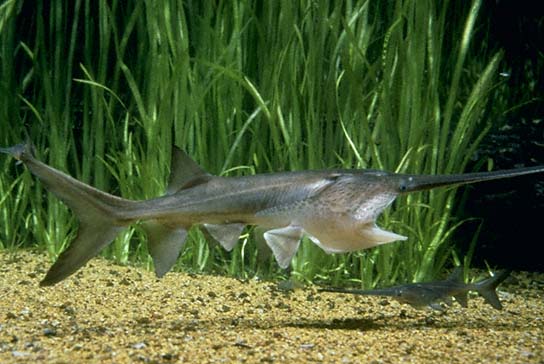Paddlefish in the home aquarium
Paddlefish are an ancient lineage of fishes whose origin predates teleost fishes by millions of years. Paddlefish are distantly related to chimeras and goblin sharks and more closely related to Sturgeons. There are two extant species of paddlefishes, the Chinese Paddlefish “Psephurus gladius”

And the North American Paddlefish “Polyodon spathula”,

The Chinese Paddle Fish has not been observed in the wild for several years and is suspected to be extinct. In the wild North American paddlefish can reach five feet long and weigh 150 pounds, its Chinese cousin can reach 23 feet in length. The two paddlefish exhibit two distinct methods of feeding, the Chinese paddlefish is a piscavore, feeding primarily on fish. The North American paddlefish is a filter feeder, feeding mostly on planktonic crustaceans, insects and the occasional small fish.
I received 12 North American paddlefish 10 weeks ago from a breeder who grows them for their roe that makes excellent caviar. In the fish breeding trade there sometimes occurs what are known as runts or dinks, these are fish which for some as yet unknown reason do not grow as large as the normal fish and usually do not live because they cannot compete with larger normal fish. My 12 fish were dinks and not expected to grow larger than a small fraction of the normal size of the paddlefish. Keeping paddlefish in the home aquarium has not been done extensively but the few dinks that have been kept have so far (4 years plus) failed to reach a size larger than 10”. Keeping these fish is an attempt by me to gather more information about these fish and to promote keeping them in captivity.
When I first received the fish two were DOA and in the next few days another two fish died leaving me with 8 fish total. Now, 10 weeks into this experiment, the paddlefish are doing great and have reached 4 to 6 inches in length while their normal hatch mates are in the 16 to 18 inch size range and growing fast, my fishes growth has slowed down almost to a stand still. These are tough fish, when I received the shipping box all the fish appeared to be dead but upon being placed in their tank all but two revived and the 8 that are left are doing great.
I feed my fish live daphnia I culture myself, live blood worms from the daphnia vats, powdered krill and the same floating pellets the fish at the breeders grow out ponds receive. Currently I have split the fish up into two groups of 4, one group is indoors in a 30 gallon (113.5 liters) aquarium and a 55 gallon (208 liters) aquarium. The outdoor group has a water temperature on average of 85 degrees, the indoor group has an average temperature of 72 degrees. The water was softened in a household water softener so I added some ions to make the water harder. One half cup of marine aquarium salt and two shot glasses of calcium chloride were dissolved in the water, an equivalent amount has been dissolved in the 55 gallon tank as well..
The outdoor aquarium is filtered by a 350 gallon an hour submersible pump pulling the water through a large sponge. The indoor aquarium is filtered by a Marineland 200 gallon an hour Penguin filter. The penguin filter intake is pre-filtered by a sponge to avoid pulling the live daphnia into the filter. The penguin filter also has a wet/dry rotating biological filter to help deal with ammonia by culturing a thin layer of bacteria at the air water interface that allows the bio-filter to operate more efficiently.
These fish are very messy, excreting wastes due to not efficiently digesting their food, much of their food goes straight through and would pollute the water if not for efficient filtration and scavenger fishes. I keep coolie loaches and cory catfish in the tanks as scavengers.
There were 7 adult black banded sunfish in the tank as well as 5 tiny baby sunfish but the paddlefish ate several of them and killed the rest by mouthing them. The paddlefish are truly pelagic and never stop swimming, here is a video of the paddlefish feeding.
More to come

Hi, this is a comment.
To delete a comment, just log in and view the post's comments. There you will have the option to edit or delete them.
Hey, nice to see you blogging!
Just a tip: WordPress doesn’t use the usual BBCode. To add an image, hit the little star by “Upload/Insert” just above the textbox. You can upload a file or hit “From URL” to link to one from anywhere.
We actually give you 50MB of space to upload images and stuff, so show off as much as you want…
Now, in the next few months I’m going to try to make the blogs more visible on SFN so everyone gets more readers and more attention. Tell everyone you know! And enjoy the blogs.
Thanks Cap’n
For the image links you want to use “img src” and in the greater/less than symbols rather than brackets. It took me a while to get used to the difference between SFN markup codes and the blog ones.
For the record I’ve always enjoyed your paddlefish thread – and congrats on the blog’n!
Quite a thing you’ve done with the fish. Has to be fun as well as educational in a sense.
I know they were in the Big Sandy, Little Sandy, The Tug and Ohio, but I personally never caught one. A friend of my Dad, Lum Harris; would bring them home, hang ’em on his smoke house, and clean them like you would a catfish. Two or three women doin’ the frying, and the neighborhood would have a ball. Good beer, good moon and a good time. By the way, Good Blog!